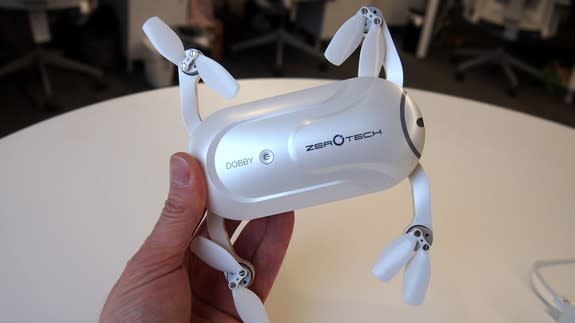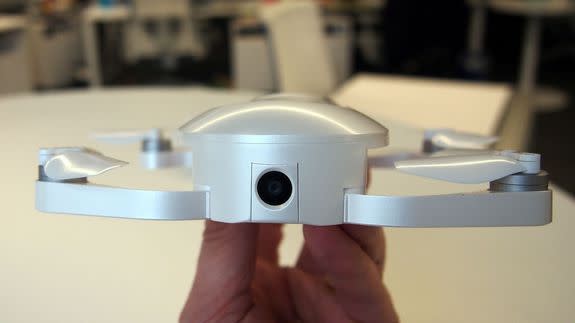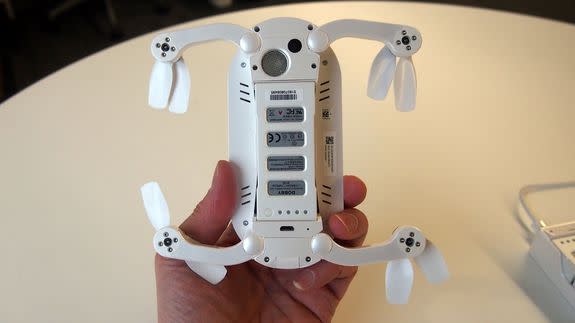Pocket-sized Dobby selfie drone is cute, tiny and way frustrating

It's a good bet that Japanese company Zero Tech was unaware of the Harry Potter connection when it named its pocket-sized drone Dobby. While that tiny house elf won us over with his tenacity and heroics, the little Dobby drone is mostly a disappointment.
It's not all bad. In fact, there's a lot of promise in Dobby.
The little quadcopter folds up into a pill-like-shape and easily fits in most pockets and small bags. It ships with two batteries, each one snaps easily into the belly of the drone.

Image: lance ulanoff/mashable

Image: lance ulanoff/mashable
At just $399, the hand-sized drone is packed full of technology you'd normally find on full-sized prosumer drones. It has a 4K-capable, 13-MP camera, as well as face detection, compass, altitude sensor, GPS and Wi-Fi. It doesn't ship with a hardware remote, but you can easily use your smartphone. You use the Wi-Fi to maintain a contact connection, the range of control defined by the range of the Wi-Fi connection (a few hundred feet).
The small battery charged quickly (under an hour) and connecting to the phone and free app, Do.Fun, is easy, as well.
To fly, first you fold out the four propeller arms, press the power button on top of the drone for three seconds and then connect to Dobby through your phone's Wi-Fi settings.
One of Dobby's best tricks is its ability to land and take off from your palm. The relatively simple interface asks you if you want to do this when you take off and land. The drone took off from my hand without issue, but I was more impressed with the palm landing. Once you place your hand under the drone's the downward-facing camera, it sees your palm and gently lands on it, turning off the propellers as soon as it hits your hand.
I would not, though, recommend drone novices try this since the tiny propeller blades, which spin at thousands of RPMs, are kind of dangerous (even the instructions recommend you keep your fingers away from them).
And if you expect this tiny drone to fly quietly, you'll be disappointed. It's loud enough to turn heads. (No spy drone for you.)
Not so good
Dobby, though, has a bunch of issues.
First and foremost is the battery. Each one lasts for, maybe, if you are very lucky, five minutes on a charge. I discovered this as I flew Dobby about 150 feet in the air and watched with alarm as the battery level, which is displayed in the app, dropped from 100% to 73% and then 30% in a couple of minutes. No wonder it ships with two batteries. You barely get started before you have to switch out to a fresh one.

Image: lance ulanoff/mashable
Dobby drone has GPS and the ability to navigate back home, but with so little battery life, you'll never get far enough to really use it. You fly up, navigate a bit and just as you're getting the hang of it, it's time to land.
And you need more time to get the hang of flying Dobby because the controls are bit odd. You have three options, Stick, Safe Sticks and Motion Sensing. Most of the time I flew with Sticks, which are virtual joysticks. They were supposed to allow me to keep my fingers in the center of the circles and gently nudge the drone in any direction, but it never worked like that, I kept having to tap the controls which made every movement sharp and jerky.
The Motion Sensing control mode, which lets you tilt your phone in the direction you want Dobby to fly, would have worked better if Dobby didn't have a habit of drifting. It doesn't take off on you (well it did once in Motion Sensing because my phone wasn't perfectly straight), but it's always slowly moving. Also, if you fly it outside, Dobby's tiny size is over-matched by the slightest breeze.
Zero Tech packed Dobby with some impressive sensors that let it track objects and people. I set it to track my face, which it did only intermittently. It would see my face, track it and then lose me if I moved a bit too much.
Take a picture it'll definitely last longer
The 13 MP camera takes fine photos. The video looks OK, but the camera has a decent amount of distortion (buildings lean). I do like that I can shoot directly on the drone (it has 16 GB of storage) and download via Wi-Fi directly to my phone. However, because the camera is built into the drone frame and not on a gimbal, the video is pretty bumpy. Obviously, if you only pay $399 for a drone, you get $399-quality video.

Image: zero tech
The concept of tiny drones that we can pull out of our pockets and use for fast, overhead selfies, group shots and on-the-go videos is compelling, but I don't know how anyone can master a drone that stays in the air for a maximum of five minutes.
Dobby wins points for looks, portability and surprising power in a small frame, but it loses on controls, video and, especially, battery life.
Harry's Potter's Dobby was a can-do kind of elf, Zero-Tech's Dobby is a can't do enough kind of drone.
Zero Tech Dobby Drone
The Good
Small • Foldable • 4K video • Lots of sensors
The Bad
Not that easy to control • Terrible battery life
The Bottom Line
This Dobby Drone is truly cute, but hard to recommend with sub-5 minute-per-charge flying time.

 Yahoo News
Yahoo News 